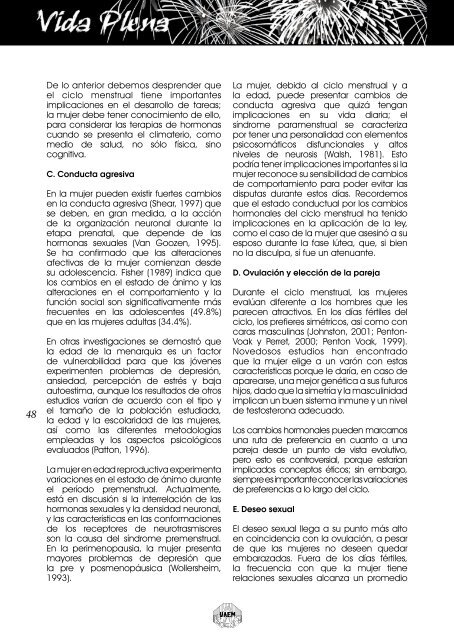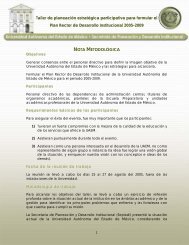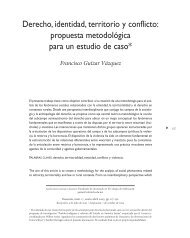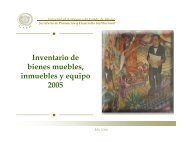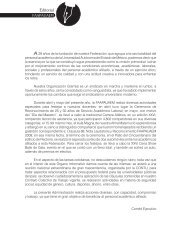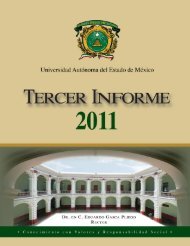Engrandecer a la mujer con su femineidad, al - Universidad ...
Engrandecer a la mujer con su femineidad, al - Universidad ...
Engrandecer a la mujer con su femineidad, al - Universidad ...
You also want an ePaper? Increase the reach of your titles
YUMPU automatically turns print PDFs into web optimized ePapers that Google loves.
48<br />
De lo anterior debemos desprender que<br />
el ciclo menstru<strong>al</strong> tiene importantes<br />
implicaciones en el desarrollo de tareas;<br />
<strong>la</strong> <strong>mujer</strong> debe tener <strong>con</strong>ocimiento de ello,<br />
para <strong>con</strong>siderar <strong>la</strong>s terapias de hormonas<br />
cuando se presenta el climaterio, como<br />
medio de s<strong>al</strong>ud, no sólo física, sino<br />
cognitiva.<br />
C. Conducta agresiva<br />
En <strong>la</strong> <strong>mujer</strong> pueden existir fuertes cambios<br />
en <strong>la</strong> <strong>con</strong>ducta agresiva (Shear, 1997) que<br />
se deben, en gran medida, a <strong>la</strong> acción<br />
de <strong>la</strong> organización neuron<strong>al</strong> durante <strong>la</strong><br />
etapa prenat<strong>al</strong>, que depende de <strong>la</strong>s<br />
hormonas sexu<strong>al</strong>es (Van Goozen, 1995).<br />
Se ha <strong>con</strong>firmado que <strong>la</strong>s <strong>al</strong>teraciones<br />
afectivas de <strong>la</strong> <strong>mujer</strong> comienzan desde<br />
<strong>su</strong> adolescencia. Fisher (1989) indica que<br />
los cambios en el estado de ánimo y <strong>la</strong>s<br />
<strong>al</strong>teraciones en el comportamiento y <strong>la</strong><br />
función soci<strong>al</strong> son significativamente más<br />
frecuentes en <strong>la</strong>s adolescentes (49.8%)<br />
que en <strong>la</strong>s <strong>mujer</strong>es adultas (34.4%).<br />
En otras investigaciones se demostró que<br />
<strong>la</strong> edad de <strong>la</strong> menarquia es un factor<br />
de vulnerabilidad para que <strong>la</strong>s jóvenes<br />
experimenten problemas de depresión,<br />
ansiedad, percepción de estrés y baja<br />
autoestima, aunque los re<strong>su</strong>ltados de otros<br />
estudios varían de acuerdo <strong>con</strong> el tipo y<br />
el tamaño de <strong>la</strong> pob<strong>la</strong>ción estudiada,<br />
<strong>la</strong> edad y <strong>la</strong> esco<strong>la</strong>ridad de <strong>la</strong>s <strong>mujer</strong>es,<br />
así como <strong>la</strong>s diferentes metodologías<br />
empleadas y los aspectos psicológicos<br />
ev<strong>al</strong>uados (Patton, 1996).<br />
La <strong>mujer</strong> en edad reproductiva experimenta<br />
variaciones en el estado de ánimo durante<br />
el período premenstru<strong>al</strong>. Actu<strong>al</strong>mente,<br />
está en discusión si <strong>la</strong> interre<strong>la</strong>ción de <strong>la</strong>s<br />
hormonas sexu<strong>al</strong>es y <strong>la</strong> densidad neuron<strong>al</strong>,<br />
y <strong>la</strong>s características en <strong>la</strong>s <strong>con</strong>formaciones<br />
de los receptores de neurotrasmisores<br />
son <strong>la</strong> causa del síndrome premenstru<strong>al</strong>.<br />
En <strong>la</strong> perimenopausia, <strong>la</strong> <strong>mujer</strong> presenta<br />
mayores problemas de depresión que<br />
<strong>la</strong> pre y posmenopáusica (Wollersheim,<br />
1993).<br />
La <strong>mujer</strong>, debido <strong>al</strong> ciclo menstru<strong>al</strong> y a<br />
<strong>la</strong> edad, puede presentar cambios de<br />
<strong>con</strong>ducta agresiva que quizá tengan<br />
implicaciones en <strong>su</strong> vida diaria; el<br />
síndrome paramenstru<strong>al</strong> se caracteriza<br />
por tener una person<strong>al</strong>idad <strong>con</strong> elementos<br />
psicosomáticos disfuncion<strong>al</strong>es y <strong>al</strong>tos<br />
niveles de neurosis (W<strong>al</strong>sh, 1981). Esto<br />
podría tener implicaciones importantes si <strong>la</strong><br />
<strong>mujer</strong> re<strong>con</strong>oce <strong>su</strong> sensibilidad de cambios<br />
de comportamiento para poder evitar <strong>la</strong>s<br />
disputas durante estos días. Recordemos<br />
que el estado <strong>con</strong>ductu<strong>al</strong> por los cambios<br />
hormon<strong>al</strong>es del ciclo menstru<strong>al</strong> ha tenido<br />
implicaciones en <strong>la</strong> aplicación de <strong>la</strong> ley,<br />
como el caso de <strong>la</strong> <strong>mujer</strong> que asesinó a <strong>su</strong><br />
esposo durante <strong>la</strong> fase lútea, que, si bien<br />
no <strong>la</strong> disculpa, sí fue un atenuante.<br />
D. Ovu<strong>la</strong>ción y elección de <strong>la</strong> pareja<br />
Durante el ciclo menstru<strong>al</strong>, <strong>la</strong>s <strong>mujer</strong>es<br />
ev<strong>al</strong>úan diferente a los hombres que les<br />
parecen atractivos. En los días fértiles del<br />
ciclo, los prefieres simétricos, así como <strong>con</strong><br />
caras masculinas (Johnston, 2001; Penton-<br />
Voak y Perret, 2000; Penton Voak, 1999).<br />
Novedosos estudios han en<strong>con</strong>trado<br />
que <strong>la</strong> <strong>mujer</strong> elige a un varón <strong>con</strong> estas<br />
características porque le daría, en caso de<br />
aparearse, una mejor genética a <strong>su</strong>s futuros<br />
hijos, dado que <strong>la</strong> simetría y <strong>la</strong> masculinidad<br />
implican un buen sistema inmune y un nivel<br />
de testosterona adecuado.<br />
Los cambios hormon<strong>al</strong>es pueden marcarnos<br />
una ruta de preferencia en cuanto a una<br />
pareja desde un punto de vista evolutivo,<br />
pero esto es <strong>con</strong>troversi<strong>al</strong>, porque estarían<br />
implicados <strong>con</strong>ceptos éticos; sin embargo,<br />
siempre es importante <strong>con</strong>ocer <strong>la</strong>s variaciones<br />
de preferencias a lo <strong>la</strong>rgo del ciclo.<br />
E. Deseo sexu<strong>al</strong><br />
El deseo sexu<strong>al</strong> llega a <strong>su</strong> punto más <strong>al</strong>to<br />
en coincidencia <strong>con</strong> <strong>la</strong> ovu<strong>la</strong>ción, a pesar<br />
de que <strong>la</strong>s <strong>mujer</strong>es no deseen quedar<br />
embarazadas. Fuera de los días fértiles,<br />
<strong>la</strong> frecuencia <strong>con</strong> que <strong>la</strong> <strong>mujer</strong> tiene<br />
re<strong>la</strong>ciones sexu<strong>al</strong>es <strong>al</strong>canza un promedio


